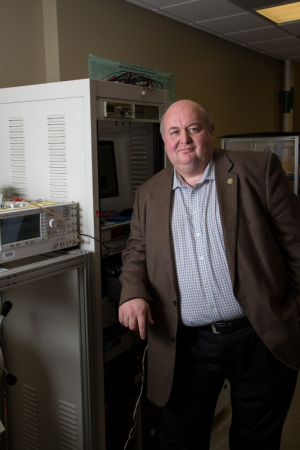You have a lot to thank Dmitri Litvinov for, though you might not know it yet.
Litvinov is the John and Rebecca Moores Professor in the Cullen College’s electrical and computer engineering department, a professor of chemical and biomolecular engineering and of chemistry, and the vice provost and dean of the UH Graduate School. He is also the director of two academic programs, a research center, and a University-wide user facility; these include the materials engineering program, the nano engineering minor program, the Center for Integrated Bio & Nano Systems, and the UH Nanofabrication Facility.
If Litvinov’s long list of titles at UH is any indication, he has accomplished quite a bit in his nearly decade-long career at the university. Thanks to his tireless work and dedication as an educator, researcher and academic leader, Litvinov has been awarded the university’s highest faculty honor, the Esther Farfel Award. The award, which was presented to Litvinov yesterday at UH’s Faculty Awards Lunch, is given annually to a professor who has excelled in teaching, research and service.
“I can’t believe I received the award,” Litvinov said. “I know the previous recipients of this award and it’s hard to believe I could be seen at the same level as those colleagues, but it feels good to be recognized.”
But even before his career in academia began, Litvinov was making strides in industry that you may owe him a “thank you” for today. Prior to coming to UH, Litvinov worked in the research division of Seagate Technology, where he championed the development of so-called "perpendicular magnetic recording" – a technology now used in nearly all computer hard drives. Thanks to the research Litvinov conducted then and continues to conduct now, he holds 26 U.S. patents and two pending patents.
Litvinov joined UH in 2003 to pursue his passion for education, basic research and technology development. Both his research and teaching are focused on nanoscale materials and devices and their applications to information technology and medical diagnostics. He explained that what he enjoys the most is when the pursuit of his personal interests results in a benefit to others.
“In everything I do I always strive to arrive at a win-win scenario for myself, the students, my colleagues and the university,” he said. “It is not much fun if I am the only beneficiary of my own work; it needs to provide tangential benefits to others, too. There is a great degree of satisfaction in this approach.”
One example of pursuing this approach is the development of research facilities which students, faculty and other researchers on campus could utilize and benefit from. Litvinov founded the UH Nanofabrication Facility, which opened in 2011 and houses state-of-the-art research instrumentation with the replacement value of over $10million. The facility now has over 300 registered users, composed mostly of graduate students and postdocs pursuing their research projects. Although Litvinov’s “home” within the university resides in the Cullen College of Engineering, the Nanofabrication Facility has been developed to support interdisciplinary research and is open to many different kinds of students and researchers, including those from external universities, non-profit organizations, government labs and industry.
“While I am an electrical and computer engineering professor, what I enjoy the most are the interdisciplinary activities that bring together faculty and students from diverse fields. This strongly influences the type of research and academic programs I tend to focus on. The interdisciplinary nature of these activities often forces one to think outside of the box, to step outside of the boundaries of traditional in-discipline programs, to find the best, most efficient path to address challenges rather than rely on well-established ways only because that is how things have been done historically,” said Litvinov. Such an approach, he explained, likely contributed the most to his successes. It allowed for better research through cross-collaboration and helped establish a practical training ground for undergraduate and graduate students at the university who are involved in programs run by Litvinov.
But Litvinov didn’t stop there. Using the experienced he gained from establishing and directing the nano engineering minor within the Cullen College as well as the interdisciplinary materials engineering graduate program, Litvinov took on a new role as the vice provost and dean of the University of Houston Graduate School. In this newly created position, Litvinov leads the university effort to cultivate and support academic excellence among all of UH’s graduate and professional education programs.
One of the more ambitious undertakings in his role as dean of the UH Graduate School was to develop a new and improved admissions system for the university. This includes the rather onerous task of transitioning away from paper-based applications to the online applications most universities in the U.S. are now using. “It’s been an interesting experience, because it has to work for everybody – the entire university, all of the students, all of the graduate programs,” he said.
While such an undertaking may seem enormous, Litvinov feels uniquely prepared for the task due to the many hats he’s worn at the university. “I’ve supervised graduate students in research and academic programs, so I know a lot about them. And as a faculty member, I have a broader perspective on the graduate programs,” he said.
But being an engineer, above all, is what Litvinov said truly sets him apart. “Being an engineer – being quantitative and evaluating whatever I do as an engineer – this helps. We can do lots and lots of things, but ultimately one needs to come up with a quantitative measure to evaluate how well things work. That’s what I want to do at the Graduate School – evaluate the data we’ve collected and try to come to a conclusion that will help us improve our programs and push the university to the next step, to the next goal.”
